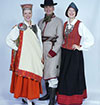 Latvian traditional costume is charming, modest, and sophisticated. Female outfits are delicate, very feminine, and have a lot of simple but very fine decorations; while male costumes are polished and noble-looking (Latvian men dressed in full sets of folk clothes make you think of landlords and noble gentlemen). The very first thing you notice in a women’s traditional costume of Latvia is a shawl and an extraordinary headdress, in men’s – a coat and a hat.
Latvian traditional costume is charming, modest, and sophisticated. Female outfits are delicate, very feminine, and have a lot of simple but very fine decorations; while male costumes are polished and noble-looking (Latvian men dressed in full sets of folk clothes make you think of landlords and noble gentlemen). The very first thing you notice in a women’s traditional costume of Latvia is a shawl and an extraordinary headdress, in men’s – a coat and a hat.
The materials were provided by the Embassy of the Republic of Latvia in Ukraine
There are two historic periods that characterize the folk clothing of Latvia: the “ancient dress” period (7th-13th century) and the “ethnic” or “ethnographic dress” period (18th-19th century). Naturally, the costumes of these periods differ, though they have some common features. For example, women used shawls and long dresses during both periods. But the male outfit is radically different.
Ancient Latvian Dress (7th-13th century)
During those centuries, the clothes were made from locally grown flax and fleece, while shoes and headdresses were often made from leather and fur. All the outfits were handmade. In most cases, people grew plants, hand weaved the cloth, hand dyed it, sewed the garments, and then decorated them by hands. It was a long and complicated process. Sometimes people bought clothes made by local craftsmen.
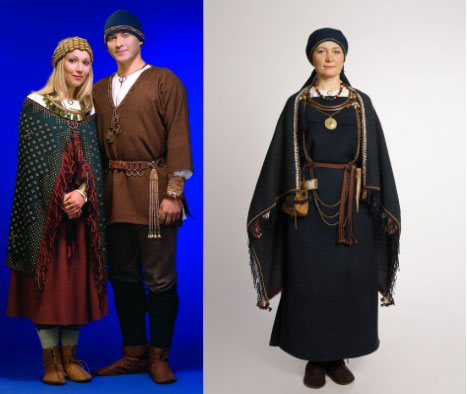
Ancient Latvians wore a lot of jewelry with their costumes. They got the jewelry pieces via trading with Scandinavia, Russia, and even the Middle East. The Ancient Latvian Dress period is well known for its usage of bronze jewelry – rings, spirals, brooches.
Latvian Ethnic Dress (18th-19th century)
During the 16th century, a part of Latvian territory got under the rule of Germany. Since then, the Latvian folk dress has a lot of German features. The 18th-19th centuries brought some serious changes into the clothing traditions of Latvia. The tradition of decorating clothes with bronze embellishments disappeared. Also, the ancient naalbinding technique was turned into knitting. The “naalbinding” or “needle-binding” is a technique of making a fabric, something between the knitting and crochet. People used a large needle, usually made from bone, to knit mittens, socks, gloves, etc. Nowadays, this craft is seldom used in Europe (mostly by historical reenactor groups), but still it is not forgotten in the Balkans and Scandinavia.
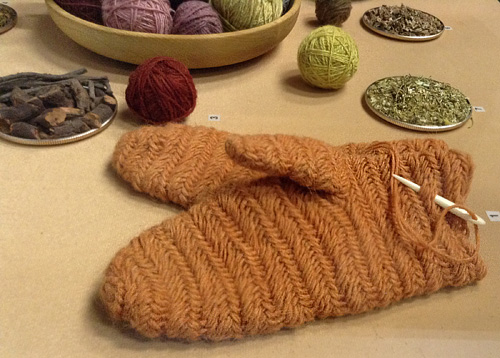
Example of “naalbinding” or “needle-binding”. These mittens were knitted in modern days but using an ancient technique
Knitting, weaving, and embroidering are very popular traditional crafts in Latvia. The differences in ornament and color help to distinguish the region of the country. According to the records from the 18th century, the most common colors of Latvian peasant’s clothes were the natural white and gray of linen and wool. To embellish the dull white and gray fabric, locals used 4 main colors in decorations: red, yellow, blue, and green.
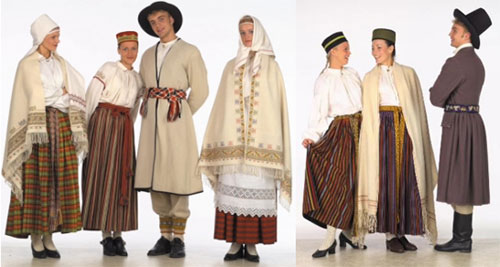
In the beginning of the 19th century, Latvian men and women wore linen garments and woolen outerwear made from homespun cloth. The traditional male costume consisted of a shirt, trousers, a coat, a belt or sash (usually, woven), socks, boots, and a hat. The male garments were linen shirts and trousers, and grey woolen coats adorned with a red, blue, or green cord. In summer Latvian men used linen overcoats and in winter – long woolen or fur coats. In the second part of the 19th century, wider color variations of fabric became available to people. So, men started using dark blue, brown, and black coats as festive outfits. Such fabric was more expensive and rare at that time.

Women wore linen shirts, long colorful skirts (handwoven), coats of various length, different woolen shawls, long woven belts, socks, shoes, and various headdresses. The favorite jewelry used by Latvian women was the silver brooches, decorated with thimble-like bubbles and/or red glass pebbles or beads.
Traditionally, female skirts were made from the striped cloth. The similar fabric was popular among the northern European nations (Finland, Sweden, the Netherlands, and Baltic countries). Latvian skirts were ankle-length, often worn with long woven belts (that reach almost to the hem of the skirt), sometimes worn with white lace aprons.
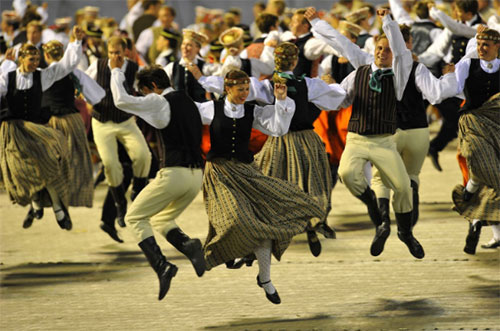
The female shawls are very delicate and beautiful. They are large: the shawl may cover only the shoulders and back or it may be thigh-length, some shawls are calf-length. Usually, they are white or beige and decorated with embroidery, fringe, and intricate brooches to fasten the ends of the garment together.
Regional differences in Latvian folk dress
There are 5 larger regions in Latvia with their own specific traditions, including the dress culture. These regions are Vidzeme, Kurzeme, Zemgale, Sēlija, and Latgale. The main variations amongst the regions are better displayed in female dresses, for example, the color schemes, different cuts, compositions, and embroidery patterns. Also, the decoration of shawls, mittens, socks, and sashes differs in each region.
Vidzeme region costume
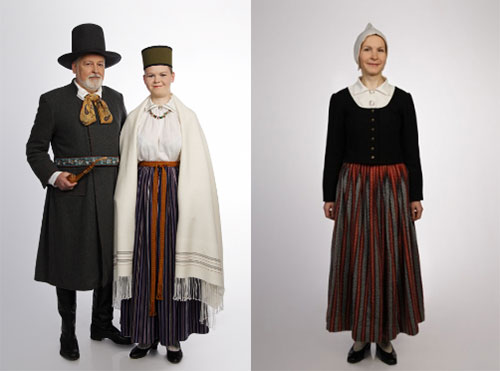
The skirt was the brightest garment of women’s dress in Vidzeme, which was multicolored and existed in many different variations. When stripes predominated, they even adorned men’s trousers and vests. Meanwhile, the white woolen shawls were richly embroidered and reached halfway to the wearer’s calf. The white festive shawls were held in place with silver brooches while the capes and scarves were never pinned. Throughout Vidzeme, married women covered their heads with tower-shape caps, usually of white linen, and sometimes tied with a silk scarf.
Kurzeme region costume
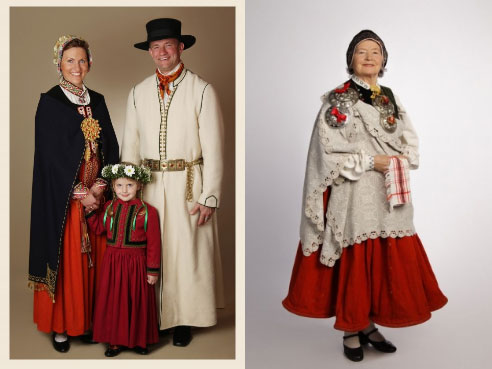
The dress of Kurzeme reflects not only the traditions of Latvians and Livs (the indigenous people) but also of closest neighbors – Lithuanians, Estonians, and Poles. A characteristic feature for the bright monochrome skirts was the ornamented lower edge, sometimes it formed a band of a different color. In the same way, a widespread tradition in some parts of Kurzeme was for both men and women to wear bronze belts, while in the seaside districts, people adorned their clothes with small amber brooches and strings of beads made from pieces of amber. More than in other regions, the garments of Kurzeme contains industrially-produced textiles (like silk, velvet, and brocade) and clothing accessories made from / decorated with glass and metal.
Zemgale region costume
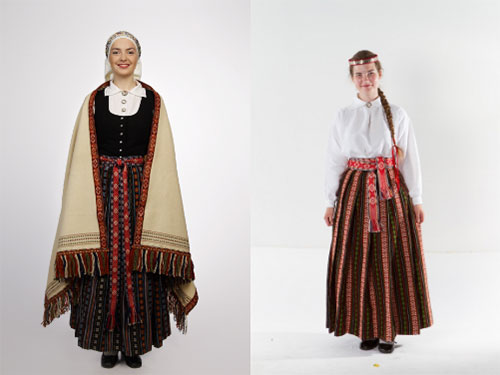
A typical for a border region, it does not show any resemblance to its neighboring Lithuanian clothing. Zemgale dress has traits of Finno-Ugric traditions, especially in the earliest examples of its garments. Nevertheless, it has developed its own unique style with vertical weft-patterned stripes. A very common is the rose motif which is followed by the zigzag, diamond, and triangle motives. A wide woven sash can be found worn above the skirt, which stood out with patterned red suns and crosses alternating on a white background, finalized with a thin thread of blue or green along the center line.
Sēlija (Augšzeme) region costume
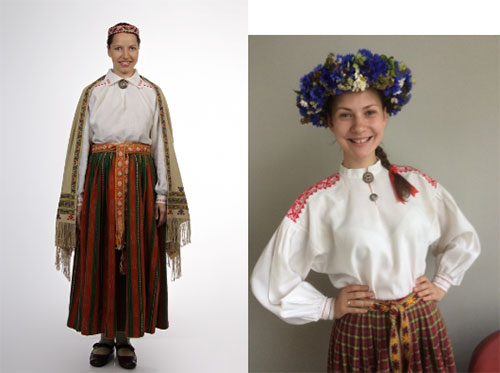
There are many similarities to that of Lithuanian dress. Nevertheless, a standout garment is the linen shirt, shaped like a tunic with sewed-in shoulder-pieces. This trait demonstrates an ancient tradition unknown anywhere else in the Baltics. The most typical Sēlija skirt has vertical stripes with tiny patterns or batik yarn. Other patterns include herringbone motifs, zigzags or twisted bicolored yarn. Among Sēlija region outfits, one will also find brightly striped or tartan skirts and elaborate white woolen shawls, richly embroidered along the edges.
Latgale region costume

Latgale region has the most international (Estonians, Russians, Belarussians, Selonians, Lithuanians) influences in the traditional dress. Skirts were usually white with a red-patterned lining on the lower edge. In the south, linen tunic shirts were of more traditional cut, sometimes with a very narrow red-decorated shoulder-piece. The skirt had vertical stripes of naturally dyed but bright colors. The white woolen shawls of this area of Latvia can be distinguished by their size and their richly embroidered ornaments in dark blue, yellow, green, and red. Characteristic throughout Latgale was the intense use of linen in clothing because garments such as shawls and skirts for summer festive attire were often made from linen.


